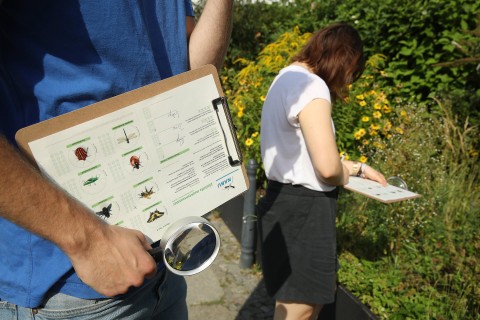Plummeting insect numbers 'threaten collapse of nature'
Damian Carrington
The Guardian
Exclusive: Insects could vanish within a century at current rate of decline, says global review
.jpg)
The rate of insect extinction is eight times faster than that of mammals, birds and reptiles. Photograph: Courtesy of Entomologisher Verein Krefeld
The world’s insects are hurtling down the path to extinction, threatening a “catastrophic collapse of nature’s ecosystems”, according to the first global scientific review.
More than 40% of insect species are declining and a third are endangered, the analysis found. The rate of extinction is eight times faster than that of mammals, birds and reptiles. The total mass of insects is falling by a precipitous 2.5% a year, according to the best data available, suggesting they could vanish within a century.
The planet is at the start of a sixth mass extinction in its history, with huge losses already reported in larger animals that are easier to study. But insects are by far the most varied and abundant animals, outweighing humanity by 17 times. They are “essential” for the proper functioning of all ecosystems, the researchers say, as food for other creatures, pollinators and recyclers of nutrients.
Insect population collapses have recently been reported in Germany and Puerto Rico, but the review strongly indicates the crisis is global. The researchers set out their conclusions in unusually forceful terms for a peer-reviewed scientific paper: “The [insect] trends confirm that the sixth major extinction event is profoundly impacting [on] life forms on our planet.
“Unless we change our ways of producing food, insects as a whole will go down the path of extinction in a few decades,” they write. “The repercussions this will have for the planet’s ecosystems are catastrophic to say the least.”

Scarce copper butterflies. Photograph: Marlene Finlayson/Alamy Stock Photo/Alamy
The analysis, published in the journal Biological Conservation, says intensive agriculture is the main driver of the declines, particularly the heavy use of pesticides. Urbanisation and climate change are also significant factors.
“If insect species losses cannot be halted, this will have catastrophic consequences for both the planet’s ecosystems and for the survival of mankind,” said Francisco Sánchez-Bayo, at the University of Sydney, Australia, who wrote the review with Kris Wyckhuys at the China Academy of Agricultural Sciences in Beijing.
The 2.5% rate of annual loss over the last 25-30 years is “shocking”, Sánchez-Bayo told the Guardian: “It is very rapid. In 10 years you will have a quarter less, in 50 years only half left and in 100 years you will have none.”
One of the biggest impacts of insect loss is on the many birds, reptiles, amphibians and fish that eat insects. “If this food source is taken away, all these animals starve to death,” he said. Such cascading effects have already been seen in Puerto Rico, where a recent study revealed a 98% fall in ground insects over 35 years.
The new analysis selected the 73 best studies done to date to assess the insect decline. Butterflies and moths are among the worst hit. For example, the number of widespread butterfly species fell by 58% on farmed land in England between 2000 and 2009. The UK has suffered the biggest recorded insect falls overall, though that is probably a result of being more intensely studied than most places.

Surveying butterflies in Maine, US. Photograph: Shawn Patrick Ouellette/Getty Images
Bees have also been seriously affected, with only half of the bumblebee species found in Oklahoma in the US in 1949 being present in 2013. The number of honeybee colonies in the US was 6 million in 1947, but 3.5 million have been lost since.
There are more than 350,000 species of beetle and many are thought to have declined, especially dung beetles. But there are also big gaps in knowledge, with very little known about many flies, ants, aphids, shield bugs and crickets. Experts say there is no reason to think they are faring any better than the studied species.
A small number of adaptable species are increasing in number, but not nearly enough to outweigh the big losses. “There are always some species that take advantage of vacuum left by the extinction of other species,” said Sanchez-Bayo. In the US, the common eastern bumblebee is increasing due to its tolerance of pesticides.
Most of the studies analysed were done in western Europe and the US, with a few ranging from Australia to China and Brazil to South Africa, but very few exist elsewhere.
“The main cause of the decline is agricultural intensification,” Sánchez-Bayo said. “That means the elimination of all trees and shrubs that normally surround the fields, so there are plain, bare fields that are treated with synthetic fertilisers and pesticides.” He said the demise of insects appears to have started at the dawn of the 20th century, accelerated during the 1950s and 1960s and reached “alarming proportions” over the last two decades.
He thinks new classes of insecticides introduced in the last 20 years, including neonicotinoids and fipronil, have been particularly damaging as they are used routinely and persist in the environment: “They sterilise the soil, killing all the grubs.” This has effects even in nature reserves nearby; the 75% insect losses recorded in Germany were in protected areas.

German conservation workers inspect an urban garden for insects. Photograph: Sean Gallup/Getty Images
The world must change the way it produces food, Sánchez-Bayo said, noting that organic farms had more insects and that occasional pesticide use in the past did not cause the level of decline seen in recent decades. “Industrial-scale, intensive agriculture is the one that is killing the ecosystems,” he said.
In the tropics, where industrial agriculture is often not yet present, the rising temperatures due to climate change are thought to be a significant factor in the decline. The species there have adapted to very stable conditions and have little ability to change, as seen in Puerto Rico.
Sánchez-Bayo said the unusually strong language used in the review was not alarmist. “We wanted to really wake people up” and the reviewers and editor agreed, he said. “When you consider 80% of biomass of insects has disappeared in 25-30 years, it is a big concern.”
Other scientists agree that it is becoming clear that insect losses are now a serious global problem. “The evidence all points in the same direction,” said Prof Dave Goulson at the University of Sussex in the UK. “It should be of huge concern to all of us, for insects are at the heart of every food web, they pollinate the large majority of plant species, keep the soil healthy, recycle nutrients, control pests, and much more. Love them or loathe them, we humans cannot survive without insects.”
Matt Shardlow, at the conservation charity Buglife, said: “It is gravely sobering to see this collation of evidence that demonstrates the pitiful state of the world’s insect populations. It is increasingly obvious that the planet’s ecology is breaking and there is a need for an intense and global effort to halt and reverse these dreadful trends.” In his opinion, the review slightly overemphasises the role of pesticides and underplays global warming, though other unstudied factors such as light pollution might prove to be significant.

Volunteers look for the wormwood moonshiner beetle in Suffolk, UK. Photograph: Sean Smith/The Guardian
Prof Paul Ehrlich, at Stanford University in the US, has seen insects vanish first-hand, through his work on checkerspot butterflies on Stanford’s Jasper Ridge reserve. He first studied them in 1960 but they had all gone by 2000, largely due to climate change.
Ehrlich praised the review, saying: “It is extraordinary to have gone through all those studies and analysed them as well as they have.” He said the particularly large declines in aquatic insects were striking. “But they don’t mention that it is human overpopulation and overconsumption that is driving all the things [eradicating insects], including climate change,” he said.
Sánchez-Bayo said he had recently witnessed an insect crash himself. A recent family holiday involved a 400-mile (700km) drive across rural Australia, but he had not once had to clean the windscreen, he said. “Years ago you had to do this constantly.”


